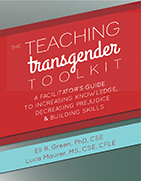Training Educators and Service Providers on Transgender Issues
By Luca Maurer, MS, CSE, CFLE | February 8, 2016
Director, The Center for LGBT Education, Outreach & Services at Ithaca College
Transgender people are in our families, our communities, our workplaces, our faith communities and our schools. They are part of the fabric of our society. Yet stigma and discrimination can make it extraordinarily difficult for transgender people to make their way in the world, and for everyone to learn accurate information about the lives and experiences of transgender people.
Professional development and training can play a vital role in preparing educators and providers to offer the best possible services to transgender people. By extension, better services can be offered to their families, and, ultimately to entire communities and our society as a whole. Training can also prepare us to be more effective in our professional (and often our personal) roles.
The effort is well worth it! Read more to be a part of building healthier, safer, more inclusive communities for all, by increasing your understanding and skills to support this underserved population.
 Luca Maurer is the coauthor, along with Eli R. Green, PhD, of The Teaching Transgender Toolkit, a collection of resources and lesson plans for teaching transgender-related information to a variety of audiences, including high school and college students, educational professionals, medical and social service providers, community groups and faith communities. The toolkit enables facilitators and trainers to provide the most accurate and effective practical training, toward the goal of increasing awareness, empathy and skills.
Luca Maurer is the coauthor, along with Eli R. Green, PhD, of The Teaching Transgender Toolkit, a collection of resources and lesson plans for teaching transgender-related information to a variety of audiences, including high school and college students, educational professionals, medical and social service providers, community groups and faith communities. The toolkit enables facilitators and trainers to provide the most accurate and effective practical training, toward the goal of increasing awareness, empathy and skills.
A Critical Time
This is a critical time for transgender people. Some of the backlash in response to recent strides toward greater acceptance of people who are lesbian, gay or bisexual is being targeted toward transgender people. As we see in recent events in Houston, Texas, and other cities and states, efforts are being made to limit or roll back rights for transgender people. Fear, misinformation and ignorance are being used as a catalyst for campaigns to strip transgender people of their rights and their ability to access the freedoms that other Americans enjoy.
At the same time, transgender people and their families, friends and loved ones are becoming more aware of the rights that have been affirmed and protections that have been established. They have become more vocal advocates in exercising those rights.
This includes school and workplace protections under Title IX and Title VII, equal treatment in health care settings under ACA, and equal treatment in education, housing and public accommodations under existing local and state non-discrimination laws that include gender identity and expression. In ever greater numbers, transgender people, along with their families and supporters, are expressing the expectation that their needs will be met—in a culturally competent, respectful and informed way—by service providers, educators and health care providers.
Changing Traditional Approaches
Traditional approaches in education and service provision have rarely incorporated strategies that include or affirm transgender people. Indeed, in most instances, these needs and experiences have not even been mentioned. Yet the research indicates that many health disparities facing transgender youth and adults may be fueled in part by a lack of affirming strategies that are meaningfully and intentionally incorporated into curricula and service delivery.
The social isolation, stigma, discrimination and trauma many transgender people experience could be mitigated by more equitable approaches. Transgender affirming education may also contribute positively to school and community climate and successful youth development. These are factors that have been identified as improving access to education and better quality of life for transgender people, and decreasing anti-transgender prejudice.
I’ve been leading trainings about transgender themes for years, in a wide variety of settings including K–12 schools, colleges and universities, health and human service organizations and more. Over the years, I’ve seen increasing numbers of people interested in participating in training so that they can better understand the needs of transgender people. Today, people are clamoring for information.
6 Ways to Promote Effective Training
Here are some concrete action steps for readers who’d like to implement professional development:
- Become familiar with resources on transgender people and themes in your local community. Is there an LGBT youth group, a community- or campus-based LGBT Center, a transgender peer support group, or a welcoming faith congregation to which you can refer? A network of educators, health care providers, or other professionals with whom you can share expertise, successes, and challenges?
- Reach out to transgender experts in your community and invite them to provide an inservice or training to your staff.
- Present a case study involving a transgender client, family member or student from your program or school district. This clarifies for your staff that they are serving transgender individuals.
- Learn about ways intersecting identities and oppressions can uniquely impact transgender people. Transgender people continue all too frequently to face discrimination, prejudice and violence – especially transgender women of color. The pervasive impacts of structural and institutional racism and of poverty disproportionality put transgender people at risk.
- Discuss the importance of professional development with leadership in your organization or program and enlist their support in the effort.
- Consider getting a copy of our resource, The Teaching Transgender Toolkit, which provides a detailed collection of best practices, lesson plans and resources for those who wish to facilitate trainings about transgender people, identities and experiences (we tell you more about the Toolkit below).
Changing Attitudes
Effective professional development helps build visibility for transgender individuals. It clarifies that they are as varied, complex and resourceful as other populations. This is vitally important! Against our current backdrop of increasing media visibility and awareness of the transgender community, it’s useful to remember that as recently as 2009, more Americans claimed to have seen a ghost than to have met a transgender person.
Despite the fact that almost 90% of Americans say they personally know someone who is lesbian, gay, or bisexual, just 16% say they personally know someone who is transgender. These figures suggest that much of what people know about transgender people comes from media portrayals. These often contain inaccuracies. They rarely display the breadth, depth and diversity of transgender people and their lives.
Although estimates are difficult to calculate (in part due to stigma and discrimination against transgender people), data suggest somewhere between 0.3 percent and 1 percent (or more) of people in the United States are transgender. That’s at least 700,000 people—or roughly the population of the state of Delaware (Go Blue Hens!).
Sometimes during a training, when I’m asked how many transgender people there are, I’ll mention this comparison. If I ask participants “Who here knows a transgender person?”, there are usually few, if any, responses.
In contrast, when I ask, “Who’s heard of Delaware? Who knows someone from Delaware?”, quite a few participants usually answer affirmatively. It’s a quick way to get a sense of participants’ experiences, while also helping establish just how important it is for everyone to be prepared to work with transgender students and clients.
Education as a Tool for Social Change
My colleague Eli Green and I have centered our careers on creating the world we wish to see: one in which all people—regardless of biological sex, gender identity, gender expression or sexual orientation—are safe, respected and affirmed. Research and our own experiences as facilitators tell us that, when implemented effectively, education is a powerful tool for reducing prejudice and instigating social change.
As with any type of education, this work can be both fulfilling and challenging. One of the consistent challenges has been the lack of tools supporting those who wish to provide professional development about transgender issues. This is why we recently compiled our experience leading transgender-related trainings and setting forth educational best practices into The Teaching Transgender Toolkit.
The Toolkit is a detailed collection of best practices, lesson plans and resources for those who wish to facilitate trainings about transgender people, identities and experiences. We’ve paid particular attention to intersectional approaches and marginalized identities. The lessons are complemented by extensive foundational knowledge about transgender lives. We offer detailed guidance on how to plan, facilitate and navigate the nuances of teaching about transgender-related topics and include resources to build further knowledge.
Worth the Effort
There are a number of benefits to building educators’ and service providers’ basic knowledge about transgender people, and building skills in providing services that are affirming and supportive. These efforts help clients, programs and providers alike.
For example:
- Transgender people and those with transgender family members will be able to get the services they need to support key areas, including physical and mental health, educational and social needs.
- Transgender people and those who have transgender family members are likely to feel more comfortable being their authentic selves—being out to you and interacting without fear or distrust. This will make your work more effective and assist you in better addressing their needs
- You and your coworkers will be more confident, knowing you are equipped to meet the needs of all you serve.
- You will enjoy the security of being in compliance with important federal and other applicable laws, and delivering services free from discrimination.
- Your knowledge and familiarity with the unique challenges and opportunities facing transgender people can help you provide opportunities for transgender students or clients. You can offer support to further develop their skills, and harness their talents in ways that benefit themselves, their schools and their communities.
- You and your school or program will model for others—colleagues students, families and community members—the positive effects of extending dignity and respect to all.
- If you work with youth in any capacity, you’ll be equipping individuals of all gender identities to interact and succeed in an increasingly diverse community, workforce and global society.
- You’ll be part of building a healthier, safer and more inclusive and affirming local community from which all may benefit.
Education and empathy are first steps toward making a difference and building a more inclusive society in which everyone may fully participate and is treated with dignity and respect. We hope our work inspires and equips others to make just such a difference. We welcome your comments, ideas and suggestions for additional ways we can all play a part in this important work.
Luca Maurer is an author, consultant and trainer on a variety of themes, including LGBTQ topics, global health, disability, diversity, inclusion and intersectionality, who works and speaks throughout the U.S. and internationally. Maurer also teaches courses on sexuality at the graduate and undergraduate levels. Maurer is Founding Director of The Center for Lesbian, Gay, Bisexual & Transgender (LGBT) Education, Outreach, and Services at Ithaca College.




